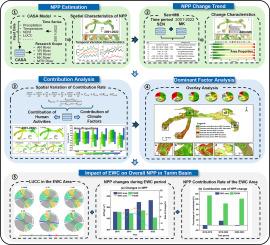Study on the synergistic effects of ecological water conveyance and climate change on ecological restoration in arid areas: A case study of the Tarim River Basin
IF 4.1
2区 环境科学与生态学
Q1 ECOLOGY
引用次数: 0
Abstract
Under the dual pressures of climate change and intensified human activities, ecological degradation and water scarcity in arid regions have become more severe, seriously threatening ecological security and carbon cycling. As a key ecological regulation strategy, ecological water conveyance (EWC) improves ecosystem functions by optimizing water allocation. This study takes the Tarim River (TR) Basin as a case, applying trend and partial derivative analyses to quantify the contributions of climate and human activities to Net Primary Productivity (NPP) changes, revealing the response patterns and driving mechanisms between EWC zones and the entire basin. From 2001 to 2022, NPP showed a fluctuating upward trend, with 25.8 % of the area significantly increasing and only 4.0 % decreasing. Human activities contributed 31.4 % to NPP increases, especially along riverbanks and Populus euphratica restoration zones. During NPP decline periods (2016–2018 and 2020–2022), EWC zones contributed −14.2 % and − 1.8 %, respectively, playing a buffering role. In contrast, during 2018–2020, their contribution reached 16.7 %, highlighting EWC's effectiveness in promoting vegetation recovery. Currently, EWC benefits are mainly concentrated in low-lying floodplains and ecological channels near rivers, while upland areas distant from water sources show limited improvement. Future efforts should focus on constructing a surface-like water network and implementing zoned rotational irrigation to optimize water use, expand restoration, and enhance ecological functions. This research offers scientific evidence for ecological restoration in the TR Basin and provides references for managing similar inland river basins in arid regions worldwide.

干旱区生态输水与气候变化对生态恢复的协同效应研究——以塔里木河流域为例
在气候变化和人类活动加剧的双重压力下,干旱区生态退化和水资源短缺日益严重,严重威胁着生态安全和碳循环。生态输水作为一种重要的生态调节策略,通过优化水资源配置来改善生态系统功能。以塔里木河流域为例,采用趋势分析和偏导数分析方法,定量分析了气候和人类活动对净初级生产力(NPP)变化的贡献,揭示了生态水文带与流域间的响应模式和驱动机制。从2001年到2022年,NPP呈波动上升趋势,25.8%的面积显著增加,只有4.0%的面积显著减少。人类活动对NPP增加的贡献率为31.4%,特别是河岸和胡杨林恢复带。在NPP下降期间(2016-2018年和2020-2022年),EWC区分别贡献了- 14.2%和- 1.8%,发挥了缓冲作用。相比之下,在2018-2020年期间,它们的贡献达到16.7%,突出了EWC促进植被恢复的有效性。目前,EWC的效益主要集中在低洼洪泛平原和河流附近的生态通道,而远离水源的高地地区改善有限。今后应着力构建地表水网络,实施分区轮灌,优化水资源利用,扩大修复,增强生态功能。该研究为TR流域的生态恢复提供了科学依据,也为全球类似干旱区内陆河流域的管理提供了参考。
本文章由计算机程序翻译,如有差异,请以英文原文为准。
求助全文
约1分钟内获得全文
求助全文
来源期刊

Ecological Engineering
环境科学-工程:环境
CiteScore
8.00
自引率
5.30%
发文量
293
审稿时长
57 days
期刊介绍:
Ecological engineering has been defined as the design of ecosystems for the mutual benefit of humans and nature. The journal is meant for ecologists who, because of their research interests or occupation, are involved in designing, monitoring, or restoring ecosystems, and can serve as a bridge between ecologists and engineers.
Specific topics covered in the journal include: habitat reconstruction; ecotechnology; synthetic ecology; bioengineering; restoration ecology; ecology conservation; ecosystem rehabilitation; stream and river restoration; reclamation ecology; non-renewable resource conservation. Descriptions of specific applications of ecological engineering are acceptable only when situated within context of adding novelty to current research and emphasizing ecosystem restoration. We do not accept purely descriptive reports on ecosystem structures (such as vegetation surveys), purely physical assessment of materials that can be used for ecological restoration, small-model studies carried out in the laboratory or greenhouse with artificial (waste)water or crop studies, or case studies on conventional wastewater treatment and eutrophication that do not offer an ecosystem restoration approach within the paper.
 求助内容:
求助内容: 应助结果提醒方式:
应助结果提醒方式:


